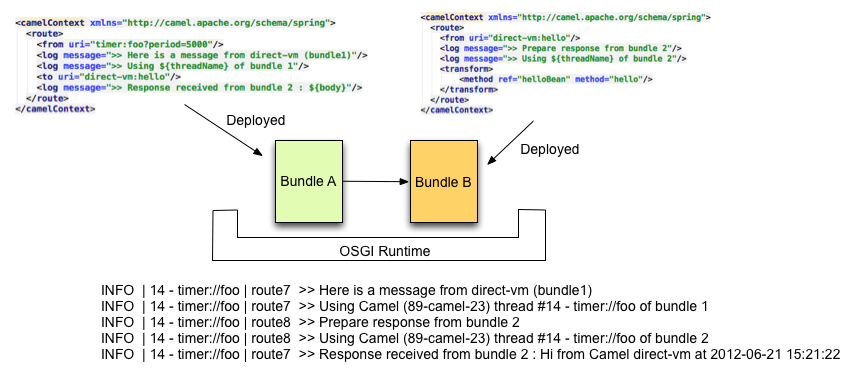Fuse 6 is no longer supported
As of February 2025, Red Hat Fuse 6 is no longer supported. If you are using Fuse 6, please upgrade to Red Hat build of Apache Camel.Este contenido no está disponible en el idioma seleccionado.
Chapter 35. Direct-VM
Direct VM Component
Copiar enlaceEnlace copiado en el portapapeles!
Available as of Camel 2.10
The direct-vm: component provides direct, synchronous invocation of any consumers in the JVM when a producer sends a message exchange. This endpoint can be used to connect existing routes in the same camel context, as well from other camel contexts in the same JVM.
This component differs from the Direct component in that Direct-VM supports communication across CamelContext instances - so you can use this mechanism to communicate across web applications (provided that camel-core.jar is on the system/boot classpath).
At runtime you can swap in new consumers, by stopping the existing consumer(s) and start new consumers. But at any given time there can be at most only one active consumer for a given endpoint.
This component allows also to connect routes deployed in different OSGI Bundles as you can see here after. Even if they are running in different bundles, the camel routes will use the same thread. That autorises to develop applications using Transactions - Tx.
URI format
Copiar enlaceEnlace copiado en el portapapeles!
direct-vm:someName
direct-vm:someName
Where someName can be any string to uniquely identify the endpoint
Options
Copiar enlaceEnlace copiado en el portapapeles!
| Name | Default Value | Description |
|---|---|---|
block
|
false
|
Camel 2.11.1: If sending a message to a direct endpoint which has no active consumer, then we can tell the producer to block and wait for the consumer to become active. |
timeout
|
30000
|
Camel 2.11.1: The timeout value to use if block is enabled. |
failIfNoConsumers
|
true
|
Camel 2.16.0: Indicates whether the producer should fail by throwing an exception when sending to a DIRECT endpoint with no active consumers.
|
Samples
Copiar enlaceEnlace copiado en el portapapeles!
In the route below we use the direct component to link the two routes together:
from("activemq:queue:order.in")
.to("bean:orderServer?method=validate")
.to("direct-vm:processOrder");
from("activemq:queue:order.in")
.to("bean:orderServer?method=validate")
.to("direct-vm:processOrder");
And now in another CamelContext, such as another OSGi bundle
from("direct-vm:processOrder")
.to("bean:orderService?method=process")
.to("activemq:queue:order.out");
from("direct-vm:processOrder")
.to("bean:orderService?method=process")
.to("activemq:queue:order.out");
And the sample using spring DSL:
